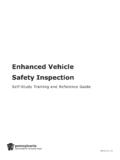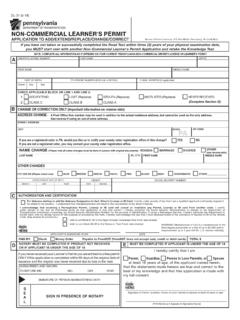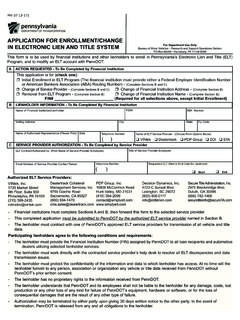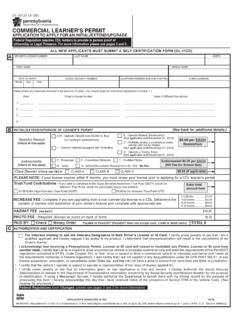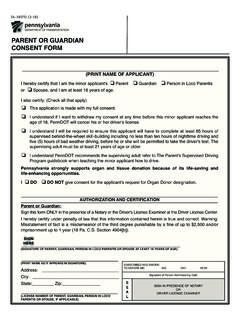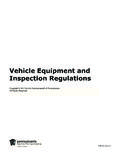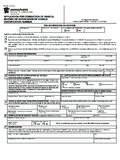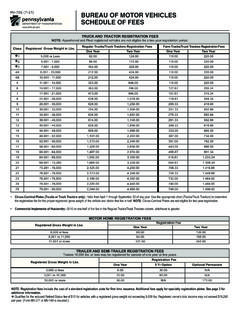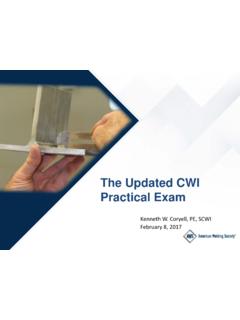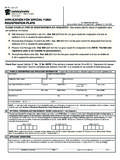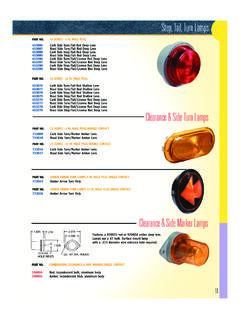Transcription of RECREATIONAL, SEMI- ANd UTILITY TRAILERS
1 Subchapter G - Recreational, Semi- and UTILITY TRAILERS Subchapter G. RECREATIONAL, SEMI- ANd UTILITY TRAILERS . Application Equipment standards set forth in this subchapter apply to TRAILERS towed or operated on highways. Suspension Every suspension component shall be in safe operating condition. Braking Systems (a) Condition of Braking Systems - Braking systems and components shall be in safe operating condition as described in (relating to inspection procedure). (b) Service Brakes - A trailer shall be equipped with a service brake system. See 75 4502 (relating to general requirements for braking systems). (1) The service brakes shall act on all wheels upon application except for the following: (i) On inter-connected dual wheels, the brakes may act upon only one wheel.
2 (ii) A vehicle being towed in driveaway- towaway operation. (iii) A trailer of a gross weight not exceeding 3,000 pounds, if the gross weight of the trailer does not exceed 40% of the gross weight of the towing vehicle. (2) The service brakes, when required, shall be capable of stopping the vehicle in not more than the maximum stopping distance prescribed in Table I. (3) Surge or inertia type brake systems are authorized. (4) The brake lining and brake fluids shall be of type approved by the vehicle manufacturer or shall meet the Society of Automotive Engineers (SAE) standards (J998 January 1980) see Appendix A (relating to minimum requirements for motor vehicle brake linings-SAE J998). (5) Metal from shoe may not contact brake drums or rotors.
3 (6) A vehicle to which additional axles and wheels have been added shall be equipped with brakes on all the additional wheels. (7) Brake lines shall be approved for use as brake lines. (c) Breakaway System - A trailer operated on a highway which is equipped with brakes or which has gross weight in excess of 3,000 pounds shall be equipped with a breakaway system which shall stop and hold the vehicle automatically upon breakaway from the towing vehicle. (d) Air Chamber Push Rod - Air chamber push rod travel may not exceed the manufacturer's specifications maximum stroke allowance. See Chart 4 (relating to brake chamber push rod travel (typical)) for drawing of air chamber push rod. Tires and Wheels (a) Condition of Tires and Wheels - Tires and wheels shall be in safe operating condition as described in (relating to inspection procedure).
4 (b) Tire Standards - A trailer shall have tires that were manufactured in conformance with standards contained in Chapter 159 (relating to new pneumatic tires). See 75 4525, (relating to tire equipment and traction surface). Tires with equivalent metric size designations may be used. (c) Radial Ply Tires - A radial ply tire may not be used on the same axle with a bias or belted tires. (d) different Types of Tires - Tires of different types and sizes, such as one snow tire and one regular tire or bias, belted or radial tires, may not be used on same axle, except in an emergency. (e) Non-Pneumatic Tires - No trailer operated on a highway shall be equipped with non-pneumatic tires. 61 Vehicle Equipment and Inspection Regulations PUB 45.
5 Subchapter G - Recreational, Semi- and UTILITY TRAILERS (f) Ice Grips or Studs - A tire may not be equipped with ice grips or tire studs of wear-resisting material which have projections exceeding 2/32 inch beyond the tread of traction surface of the tire. (g) Tires and Rims - The axles of a vehicle specified under this subchapter shall be equipped with the number and type of tires and rims which have a load rating equal to or higher than those offered by the manufacturer. Lighting and Electrical Systems (a) Condition of Lamps and Switches - Every required lamp or switch shall be in safe operating condition as described in (relating to inspection procedure). (b) Lighting Standards - All lamps shall comply with Tables II-IV; Chapter 153 and 75 Chapter 43.
6 (relating to lighting equipment). (c) Other Required Lamps - A trailer shall have at least one red stop lamp on each side of the rear of the vehicle, which shall be illuminated immediately upon application of the service brake. (d) Illumination - A trailer shall be equipped with parking lamps, stop lamps , tail lamps, turn signal lamps and hazard warning lamps designed for that specific function, which under normal atmospheric conditions, shall be capable of being seen and distinguished during nighttime operation, at a distance of 500 feet. See 75. 4303(b) (d) (relating to general lighting requirements). (1) stop lamps , turn signals and hazard warning lamps shall be visible at a distance of 100 feet during normal sunlight.
7 (2) Rear lamps shall be lighted whenever headlamps, fog lamps, or auxiliary driving lamps are in operation. (3) A trailer shall be equipped with hazard warning lamps, unless these lamps were not included as original equipment. (4) The turn signals shall have a frequency of flash between 60-120 flashes per minute. (e) Condition and Position of Lamps - Lamps shall be properly fastened; direct light properly; be of a color not contrary to Tables II-IV (relating to required motor vehicle lighting equipment; location of required equipment and required motor vehicle lighting equipment); and may not be so obstructed by a screen, bar, auxiliary equipment or device of any kind as to obscure, change color of or obstruct the beam.
8 (f) Ornamental Lamps - A lamp not enumerated in this section, and not located as described in Tables III-V of this chapter is prohibited unless it is available as original equipment. An illuminated sign is prohibited. Flashing or revolving lights are not ornamental lamps. Provisions relating to flashing or revolving lights are located in Chapters 15 and 173 (relating to authorized vehicles and special operating privileges; and flashing or revolving lights on emergency and authorized vehicles). (g) Back-Up Lamps - Back-up lamps, if the vehicle is so equipped, shall turn off automatically when the vehicle goes forward. (h) Registration Plate lamp - A registration plate lamp , if originally equipped, shall emit white light and make the registration plate visible from a distance of 50 feet to rear of vehicle.
9 (i) Trailer - A trailer that is less than 30 inches in overall width may be equipped with only one of each of the following lamps and reflective devices, located at or near its vertical centerline: tail lamps, stop lamp and rear reflex reflector. Glazing (a) Condition of Glazing - Glazing, including rigid plastic, shall meet the requirements of Chapter 161 (relating to glazing materials). See 75 4526 (relating to safety glass). (b) Safety Glazing - A trailer except house TRAILERS , shall be equipped with safety glazing in all windows and wings. Requirements of this subsection do not apply to a vehicle manufactured or assembled before January 1, 1934, if the original glazing is not cracked or discolored. Body (a) Condition of Body - All items on the body shall be in safe operating condition as described in (relasting to inspection procedure).
10 Vehicle Equipment and Inspection Regulations PUB 45 62. Subchapter G - Recreational, Semi- and UTILITY TRAILERS (b) Protruding Objects - A trailer shall have no torn metal, glass or other loose or dislocated parts protruding from the body. (c) doors - A vehicle specified under this subchapter shall be equipped with doors of a type used as original equipment. The doors shall open and close securely. Tailgates may be replaced with wood planking, nets or other material that will prevent loss of load. Tailgates may be removed when optional equipment is added. Chassis (a) Condition of Chassis - All items on the chassis shall be in safe operating condition as described in (relating to inspection procedure). (b) Vehicle Frame - The vehicle frame shall be in solid condition.
